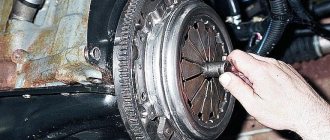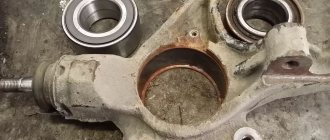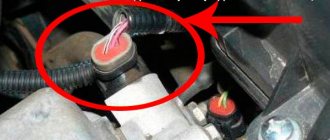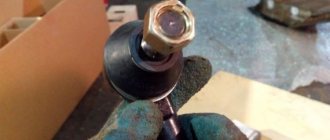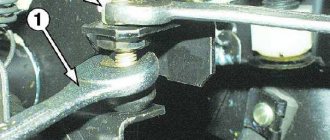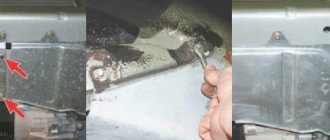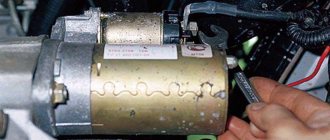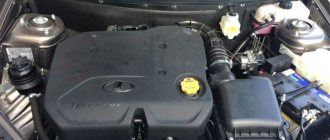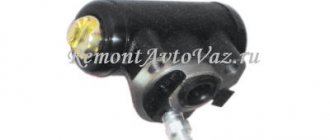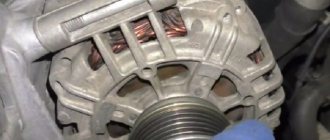How is the clutch master cylinder constructed?
The clutch system performs the function of briefly disconnecting the internal combustion engine from the gearbox. As a result, the transmission of torque from the power unit to the drive shaft of the transmission stops. This system includes many components. One of them is the clutch master cylinder, which we will talk about today.
What is he?
This mechanism is a small casting made of cast iron steel with a flange for attachment to the body. On its top there is a plastic tank with a lid. It is attached to the body using a threaded fitting. Thanks to this mechanism, a special fluid enters the clutch master cylinder. Inside the cast iron part there is a piston with a cuff and an o-ring. There is also a spring resting on the check valve. It compresses the piston to the extreme right. When these parts are heated, expansion occurs, and accordingly, the liquid in the system must go somewhere. For these cases, there is a special compensation hole through which it enters the tank from the cylinder cavity.
How does the VAZ 2107 clutch master cylinder work?
This mechanism is designed in such a way that each time you press the clutch pedal, it moves forward using a pusher. And when the piston closes the hole, the pressure in the cylinder increases. Thus, the fluid flows to the working cylinder and disengages the clutch. When the pedal is released, a similar action occurs, only in reverse order. The liquid flows back - the valves open, the spring compresses and it moves from the working cylinder to the main one. If the pressure level drops to a point below the spring compression force, the first part closes and more pressure is generated in the system. This is necessary to sample the gaps of the mechanical part of the drive.
If the pedal is released abruptly, then the liquid will not completely fill the space behind the piston. Then a vacuum occurs in the clutch master cylinder. Because of this, the liquid will flow from the plastic tank through the bypass hole directly into the piston. Then it passes through the piston head and fills all the space that appeared in the part after the vacuum. At the same time, the liquid removes the edges of the cuff and pushes the spring plastic aside. And again, if it becomes more than normal, all of its excess passes through a special compensation hole back into the tank.
This is exactly how the VAZ clutch master cylinder is designed. In conclusion, I would like to note several ways by which you can independently identify the breakdown of this mechanism:
- First, you should check the level of working fluid in the tank. If this indicator drops rapidly, this indicates a malfunction of the piston or cuff.
- Secondly, this part is replaced if you feel the characteristic sound of gears when changing gears.
- Thirdly, the clutch cylinder is replaced when the gearshift knob vibrates.
Design and principle of operation of the GCS
To begin with, a hydraulic clutch consists of a pair of cylinders (clutch master and slave cylinders) that allow the clutch to operate hydraulically. As for the master cylinder, the design of the main cylinder and its operating principle is as follows:
- the force from the clutch pedal is transmitted through the pusher to the rod. Next, the piston extends, as a result the valve closes, as a result of which the liquid from the part of the cylinder where it is compressed is able to flow into a separate tank;
- the liquid compressed in the cylinder is pushed through the fitting, after which it enters the hydraulic line, through which it is supplied to the working cylinder;
- the working cylinder acts on the fork, transmitting force to it. After the driver releases the clutch pedal, the piston of the cylinder returns back using a spring.
Please note that when choosing a new part, you must take into account individual technical characteristics, method of fastening, connection, the presence of a tank in the kit, body material, dimensions, rod length, fitting diameter, etc.
In other words, when choosing a master cylinder for a particular car, you need to take into account a number of parameters and features. It is also recommended to pay special attention to the material of manufacture. The fact is that cylinders can be either steel, aluminum or cast iron, or plastic (made from polymers).
Products made of cast iron and aluminum are quite common and are an “average” option in terms of quality; plastic cases are the most affordable, but are not always reliable and have a long service life. As for steel, such cylinders are the most reliable, but have a high cost due to the complexity of manufacturing.
Clutch slave cylinder - operating principle. Repair and replacement.
As you know, on rear-wheel drive cars of domestic production, the clutch is released not by a cable as on front-wheel drive counterparts, but with the help of hydraulics, I will now tell you in a little more detail about how this happens.
How it works.
When you press the clutch pedal with your foot, the metal rod presses on the piston, which in turn creates pressure. Under this pressure, the liquid through a system of tubes reaches the working cylinder, to which a rod with a fork is attached, and under the influence of hydraulic pressure, the rod presses the release bearing and disconnects the engine from the transmission. After releasing the clutch pedal, the spring returns the engagement of the engine and gearbox. A very sophisticated way to release the clutch. Moreover, squeezing a hydraulic clutch is somewhat more pleasant than squeezing a cable clutch. If you compare them, the hydraulics work much softer and smoother.
Due to the appearance of an “extra” structure in the form of a pair of cylinders and aluminum tubes, which tend to constantly leak, we are gradually moving on to repairing and replacing the cylinders.
Repair and replacement of the clutch slave cylinder.
1. First of all, you need to pump out the hydraulic fluid using a syringe.
2. For ease of dismantling, remove and put aside the expansion tank.
3. Using a 10″ socket, unscrew the nuts securing the clutch barrel from which we pumped out the fluid and remove the hose.
4. Unscrew the aluminum tube coming from the clutch master cylinder.
5. Using a 13″ socket, unscrew the two nuts securing the clutch master cylinder and pull it towards you.
6. Using a 17″ wrench, unscrew the hose from the working cylinder.
7. Using a 13″ socket, unscrew the two nuts securing the clutch slave cylinder and remove it. After the working cylinder is dismantled, it needs to be inspected for damage to the cylinder and piston, but if everything is in order with them, you can try to repair it. To do this, you will need a repair kit, which contains three different cuffs and a boot. The working cylinder is disassembled and the old cuffs are replaced with new ones. Finally, install a new boot.
If the working cylinder cannot be repaired, then we buy a new one and screw the nut onto it at the same distance as on the old cylinder.
The price for a new clutch slave cylinder ranges from 270 to 450 rubles, and a new master cylinder will cost 300-500 rubles, depending on the region.
Work performed when replacing the clutch master cylinder
The procedure required when replacing the clutch master cylinder is simple:
- Having unscrewed the tank, use a syringe to pump out the hydraulic fluid;
- disconnect the master cylinder from the clutch pedal, which is sometimes difficult;
- disconnect all hoses and plug those from which liquid is flowing;
- unscrew the nuts securing the cylinder to the car body;
- replace with a new clutch master cylinder and install in the reverse order;
- bleed the clutch system.
For the clutch bleeding procedure you will need:
- a suitable bleeding hose that fits tightly onto the air valve located on the working cylinder;
- container for draining hydraulic fluid;
- corresponding key for the valve;
- the liquid itself.
Description and testing of the clutch
Description and testing of the clutch
Models with RT are equipped with a dry-type single-plate clutch with a diaphragm spring.
Components of a Typical Clutch Assembly
| 1 - Pressure plate 2 - Clutch plate 3 - Shift lever 4 - Release bearing 5 - Ball pin 6 - Lever mounting spring |
The clutch is operated by a hydraulic system.
When the clutch pedal is depressed, hydraulic fluid (pressured by the clutch master cylinder) transfers power to the slave cylinder. Since the slave cylinder is connected to the clutch release fork, the release fork brings the release bearing into contact with the pressure plate petals, disengaging the clutch disc.
The hydraulic system adjusts the clutch automatically, so no additional actuator or pedal adjustment is required unless you have replaced the clutch master cylinder and/or pushrod.
When working with the instructions, problems may sometimes arise with terminology related to clutch components, because... Different manufacturers, auto parts store salespeople, and car dealers call the same parts differently. For example, the driven disc is also called the clutch disc and the friction disc; the slave cylinder is sometimes called the working cylinder, etc.
Components with obvious damage should be replaced, but for cases where the cause of system failure is not so obvious, here are a few preliminary diagnostic checks.
|
Symptoms of a faulty clutch - DRIVE2
When the vehicle is used intensively, various clutch malfunctions may occur. There are malfunctions of the clutch itself and malfunctions of the clutch drive. Clutch malfunctions include:
wear and damage to the driven disk linings; deformation of the driven disk; oiling of the driven disk linings; wear of the driven disk splines; wear or breakage of damper springs; breakage or weakening of the diaphragm spring; wear or breakage of the clutch release bearing; wear of the flywheel surface; wear of the pressure plate surface;
jamming of the clutch release fork.
Depending on the type, the clutch drive may have the following malfunctions:
a) mechanical drive
jamming, elongation or damage to the cable; damage to the lever system;
b) hydraulic drive
clogging of the hydraulic drive; violation of the tightness of the system (leakage of working fluid, presence of air in the system);
malfunction of the working cylinder (damage to the cuff).
Wear and breakdown of clutch structural elements occur mainly due to violation of vehicle operating rules: starting at high speeds, foot on the clutch pedal while driving.
One of the reasons for breakdown or wear may be the limiting service life of the clutch elements. This applies to a greater extent to the clutch driven disc, which has a limited resource. If the operating rules are followed, this element will serve regularly for over 100 thousand kilometers. For “racers” the clutch rarely lasts up to 50 thousand km.
The cause of clutch failure can also be poor quality components. When purchasing spare parts, preference should be given to original parts.
Oiling of the friction linings of the driven disc occurs when oil gets on them due to wear or damage to the oil seals of the engine or gearbox.
Clutch malfunctions are easily diagnosed by external signs. However, one external sign may correspond to several clutch malfunctions. Therefore, specific clutch malfunctions are usually identified during its disassembly.
External signs of clutch malfunctions are:
incomplete disengagement (the clutch “drives”); incomplete engagement (the clutch “slips”); jerking when the clutch operates; vibration when the clutch is engaged;
noise when disengaging the clutch.
Incomplete shutdown is accompanied by difficulty shifting gears while the engine is running, noise, crackling noise when changing gears, and increased free play of the clutch pedal.
“Slipping” of the clutch is characterized by a burning smell from the friction linings of the driven disc, insufficient vehicle dynamics, engine overheating, and increased fuel consumption.
External signs and corresponding clutch malfunctions:
the clutch “drives”:
deformation of the driven disk; wear of the splines of the driven disk; wear or damage to the lining of the driven disk; breakage or weakening of the diaphragm spring; malfunction of the working cylinder; clogging of the hydraulic drive; violation of the drive seal; jamming, elongation or damage to the cable;
damage to the linkage system
clutch slips:
wear or damage to the driven disk linings; oiling of the driven disk; breakage or weakening of the diaphragm spring; wear of the flywheel working surface; clogging of the hydraulic drive; malfunction of the working cylinder; jamming of the cable;
clutch release fork sticking
jerking when clutch operates:
wear or damage to the driven disk lining; oiling of the driven disk; jamming of the driven disk hub on the splines; deformation of the diaphragm spring; wear or breakage of the damper springs; warping of the pressure disk;
loose engine mounts
Vibration when engaging clutch:
wear of the splines of the driven disk; deformation of the driven disk; oiling of the driven disk; deformation of the diaphragm spring;
loose engine mounts
noise when disengaging the clutch:
wear or damage to the clutch release bearing
Clutch master cylinder - design, repair and replacement
If we simplify the formulation of the actions performed by the clutch drive, it will sound like this - the transmission of torque from the motor to the corresponding gearbox shaft with the ability to disable and then softly engage after switching to the desired gear. Nowadays, designers have not yet come up with anything more effective for achieving this goal than a hydraulic clutch drive. The diagram and principle of operation of the described device is simple: a depressed pedal acts on the clutch cylinder rod, which, accordingly, using hydraulic fluid located in the tank through tubes, activates, through the working cylinder, the fork and the release bearing.
Failure of the clutch drive occurs for several reasons, one of which may be a faulty clutch master cylinder; in order to repair it, it is advisable to understand its structure, signs indicating the inoperability of the mechanism, methods of repair, and if repair is not possible, then how to make it replacement.
Device
Possible malfunctions and their diagnosis
Repair work
If the pedal fails, in order to avoid unreasonable disassembly of the cylinder, it is worth initially pumping the system and expelling air from there that could get in when the liquid in the tank drops below the minimum permissible level. If this does not help in principle, it is worth starting repairs. For this case, there is a repair kit for the clutch master cylinder on sale, which, depending on the make of the car, contains the main wearing parts: cuffs, return spring, rod, retaining ring, etc.
The master cylinder is located under the clutch pedal. Depending on the car model, dismantling will have to be done either from the engine compartment or from the car interior, having previously dismantled the floor covering in the driver’s area. Having removed the clutch master cylinder, we begin disassembling it, after which we need to wash all the parts. During the subsequent inspection, after disassembly, it is worth paying special attention to the body and the condition of the rod and mirror; if there are visible scuffs, this may indicate the appearance of wear in the cylinder or wear of the rod.
In general, experienced craftsmen recommend changing all the parts in the repair kit, especially the cuffs.
Clutch faults
During the operation of the clutch, various problems may occur, the symptoms of which may be knocking and extraneous noise, incomplete engagement or disengagement, non-return or sticking of the pedal, slipping or sudden engagement, and so on.
Signs of a car clutch malfunction
Knocks and extraneous noises
Rattling, tapping and other noises during switching on may be due to:
- Sufficiently large settlement, defects or damage to the damper springs (vibration damping mechanism);
- wear (depletion) of openings for damper springs;
- deterioration or damage, deformation of the linings;
- loosening the fastening rivets securing the linings;
- deformation or damage to the HP surface.
All of the above problems are eliminated when replacing the VD with a new analogue. In some cases, extraneous noise may be caused by a lack of lubrication, or damage due to wear, or significant deformation of the release bearing housing. Accordingly, to eliminate the malfunction, you will have to replace the bearing.
Pedal squeaking can occur in two cases:
- lack of lubrication on plastic bushings;
- high wear (wear) of bushings.
For lubrication, CV joints-4 or Litol-24 are usually used. When replacing damaged elements with new analogues, they must also be treated with lubricant. It very rarely happens that the fork can bend strongly as a result of deformation and then the clutch pedal simply cannot be pressed. In such cases, it is recommended to simply replace the damaged part.
Clutch not fully engaged or not engaged
Slipping usually appears when you sharply press the gas, when the speed increases, but no noticeable acceleration is observed. In this case, a characteristic burning smell may appear. If slippage is detected, which indicates that the clutch is not fully engaged, the reason should be sought in the following:
- the surface of the flywheel, pressure plate (pressure plate) or linings is oily;
- increased production (wear) or burnout of linings;
- insufficient rigidity of the diaphragm spring;
- swelling of the cuffs of the main cylinder (main cylinder), which leads to a slow return of the piston.
First wipe oily surfaces with gasoline or white alcohol, and then dry them thoroughly until completely dry. You should also find out the cause of the oil leak. This may be a violation of the engine or gearbox seals.
If the friction linings have become unusable, replace the HP with a new analog assembly.
Insufficient rigidity of the diaphragm spring does not provide sufficient force for hard contact, which is why slippage occurs. Simply replace the “basket” (pressure plate) with a new set along with the housing.
To restore the performance of the master cylinder, you can replace the cuffs or purchase a new spare part assembly.
The clutch does not disengage when the flywheel sticks to the disc. This sometimes happens when the car is parked for a long time. You need to break the disc by starting to move without pressing the pedal. After accelerating, depress the pedal and brake sharply.
Jerking when engaging the clutch
Characteristic jerks at the beginning of movement after engaging the clutch can mainly be caused by the following circumstances:
- sticking of the hub on the shaft splines;
- disc deformation;
- wear, wear, damage and weak fastening of the linings;
- weak elasticity of the plates;
- failure of the damper spring;
- the appearance of scoring on the contacting surfaces of the basket and/or flywheel.
The hub may stick if there is heavy dirt, wear or damage to the shaft splines. First, you should clean the parts and inspect them carefully. If necessary, replace damaged elements with new spare parts.
If wear and insufficient fastening of the linings, changes in the shape of the disk, weak elasticity of the plates and/or springs are detected, a new disk must be installed.
When scoring appears on the working surfaces, as a rule, the flywheel or basket with casing is replaced.
Clutch not disengaging
When disengaging is difficult or the clutch is slipping, the causes of the malfunction can most often be due to the following points:
- insufficient (too short) pedal travel;
- presence of air;
- weak fastening of the linings;
- wear or scoring on the surfaces of the HP and flywheel;
- erasing overlays;
- distortion or damage to the ND;
- hub sticking;
- VP jamming;
- Damage or wear out of the diaphragm spring.
First of all, if the clutch does not disengage, you should adjust the drive or install a new fork instead of the damaged part.
If air gets into the system, bleed it and check the connections. Inspect the system; if any deformation or damage is detected, replace them with new analogues.
Pedal failure
When the clutch pedal fails and does not return, there may be several reasons:
- breakage or major deformation of the fork;
- violation of the elasticity of the pedal return spring;
- presence of air;
- GC pollution;
- wear and defect of the main center mirror;
- damage or wear of the cuff;
Damage to the fork or insufficient spring elasticity can be eliminated by replacing it with new parts.
If there are air pockets in the system, bleed it.
If there is a problem with the master cylinder, first clean it and replace the cuffs. If during disassembly defects or significant damage to the main engine components are discovered, install a new cylinder assembly.
Hydraulic drive device
The hydraulic drive system has the same design for all types of cars, and includes well-known elements:
- directly the clutch pedal;
- clutch master cylinder located immediately behind the pedal;
- Next comes the working cylinder;
- clutch fork;
- bearing;
- pipelines.
The master cylinder itself cannot boast of complexity - the steel case contains a piston with a pusher and cuffs that serve to ensure the tightness of the entire system within which the working fluid circulates. It takes the load from the pedal, increases it and transmits it further, providing a quick interruption in the transmission of torque from the engine when a person needs it.
Popular models and manufacturers
When choosing a non-original clutch slave cylinder, products from the following manufacturers are most often used:
- Sachs. The German company is a leading manufacturer of clutch cylinders for most automobile brands of foreign and domestic manufacturers. The popularity is due to the high quality of products and the use of innovative developments.
- Lukas. The largest manufacturer of auto parts, whose products meet all international quality standards. It produces brake cylinders for most automobile brands and repair kits for them.
- Fenox. Specializing in the production of clutch and brake cylinders for more than 25 years. Supplies products to most automakers.
- TRW. The company owns the Lukas brand and supplies brake system components, in particular brake cylinders, for all the world's largest automakers. The products are distinguished by their quality and extreme reliability.
- LUK. Official partner of major automakers in terms of designing new developments and systems. Supplies clutch cylinders to assembly lines of most of the world's major automakers.
DIY repair
Since the main cylinder, despite its importance, is designed quite simply, it is quite possible to repair it yourself without contacting specialized service centers. Of course, this will require spending some time and money, but it is much more important to have a fully functional clutch system, the sudden failure of which can end quite sadly. In order to always be able to count on your car, you should periodically diagnose its main components and systems.
Despite its importance, checking the master cylinder is a simple procedure - periodic visual inspections and checking the brake fluid level are sufficient. These actions are carried out literally in a few minutes, because if the clutch master cylinder leaks, the symptoms of this problem will be obvious - the surface of the cylinder will be stained, the level of brake fluid in the reservoir is below the established norm. At the same time, its complete replacement is not always necessary, because almost every car owner can sort out the old cylinder.
Possible malfunctions and their causes
As such, there are no faults classified as serious and difficult to fix in the clutch master cylinder. Among the most common are the following:
- airiness of the system;
- leakage of working fluid;
- mechanical wear of cylinder elements.
Air ingress can become a serious problem, making normal operation of the hydraulic drive impossible. The reason for air getting inside the system is often microcracks in the connecting hoses or sealing cuffs itself. In order to eliminate the possibility of failure, the system requires bleeding. It can be performed independently, since no special skills or special tools are required. The procedure is quite standard, and most car owners are familiar with it firsthand.
If, when checking the system, you constantly need to add brake fluid to the reservoir, you should carefully look for the place of its leak - it may not only be the clutch master cylinder. A fluid leak is dangerous primarily because the cylinder will not be able to generate sufficient force to move the clutch fork, and the driver will not be able to break the connection between the engine and the wheels by pressing the pedal. If the leak is caused by problems with the connecting pipes, replacing them is easy; if the problem is in the cylinder itself, to repair it yourself you will have to dismantle it, disassemble it and find out the cause experimentally. Faults in the clutch master cylinder cannot be detected by eye.
DIY master cylinder repair
To carry out the work, the entire assembly will have to be completely dismantled, having first disconnected all the pipes and drained the liquid from the system. You should also prepare in advance a repair kit for the clutch master cylinder, which includes all parts subject to wear. Despite the fact that the “composition” of the clutch master cylinder is not complicated, it is advisable to carry out the work by persons who have at least minimal experience in plumbing work. If the question of how to remove the clutch master cylinder is completely unclear, it is better to abandon repairs yourself and simply replace the cylinder with a new one.
After dismantling, you can begin disassembly, which should be done in a clean and well-lit place. Having disassembled the cylinder, all its parts are thoroughly washed with brake fluid - it is unacceptable to use solvents or gasoline for this purpose. It is also advisable to wash all parts from the repair kit that are planned to be used before installation. It is advisable to start removing the clutch master cylinder in the morning, especially if serious problems with the hydraulic drive were noted during the operation of the car - it may well turn out that the cylinder will not be suitable for repair, and you will urgently have to purchase and install a new one. You can watch the video to see how to replace the cylinder with your own hands:
Visual inspection of parts - what to look for
After dismantling and completely disassembling the master cylinder into its component elements, you can begin to assess the technical condition of all parts, which by that time have been washed and dried. First of all, carefully inspect the piston, mirrors and sealing elements. Quite often, pockets of corrosion can be found on internal surfaces; they can be eliminated by careful treatment with fine-grained sandpaper. Although, if the corrosion areas are multiple, extensive, and accompanied by the presence of scuffing, you should think twice about it, since this indicates a violation of the gap between the piston and the cylinder walls.
All sealing elements are inspected either very carefully, or new ones are immediately prepared, which in any case is more advisable. There may not be obvious signs of integrity damage on them, but when working under pressure, the slightest defects will inevitably lead to fluid leaks from the cylinder. After all faults have been eliminated, the device can be assembled, strictly following the sequence of manipulations.
The cylinder repair is complete, what next?
After replacing the clutch master cylinder or repairing and reinstalling the old one, it is almost always necessary to bleed the clutch system. This is a necessary measure to eliminate accumulated air bubbles, the presence of which is not allowed in the hydraulic drive system. During repairs, air inevitably enters the system, and if it is not removed, clutch problems will soon arise. The whole pumping procedure is not so complicated and does not require much time. If the replacement was carried out at a service center, its mechanics use heavy vacuum pumps to remove air from the cylinder, and bleeding of the system is not required.
For bleeding, it is necessary to provide free access to the master cylinder, and for this it will be more convenient to drive some vehicle models into a pit or lift them on a hydraulic lift. New brake fluid is poured into the reservoir, a transparent tube is put on the fitting, the end of which is lowered into a container with the same working fluid. By rhythmically operating the clutch pedal, the hydraulic drive is pumped until the release of air through the fitting stops completely. After this, the fitting is tightened and the car is ready for use.
Despite the apparent “insignificance” of this procedure, the operating principle of the clutch master cylinder does not allow the hydraulic drive to function normally in the presence of air. If bleeding is not performed, even after replacing the unit with a new one, all the characteristic signs of a malfunction of the clutch master cylinder will very quickly begin to appear, negating all previously applied efforts.
